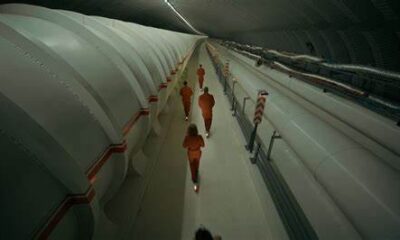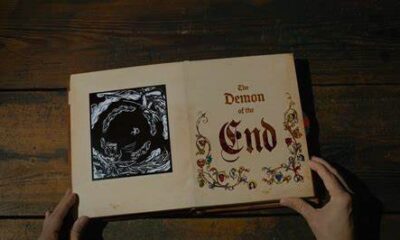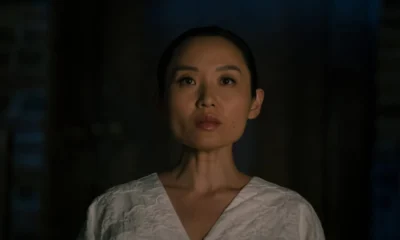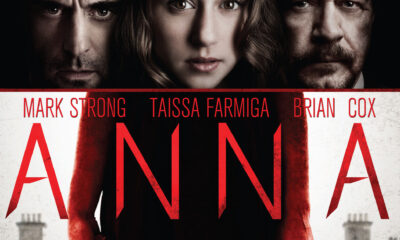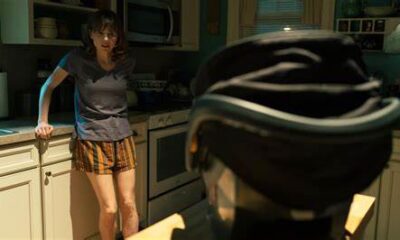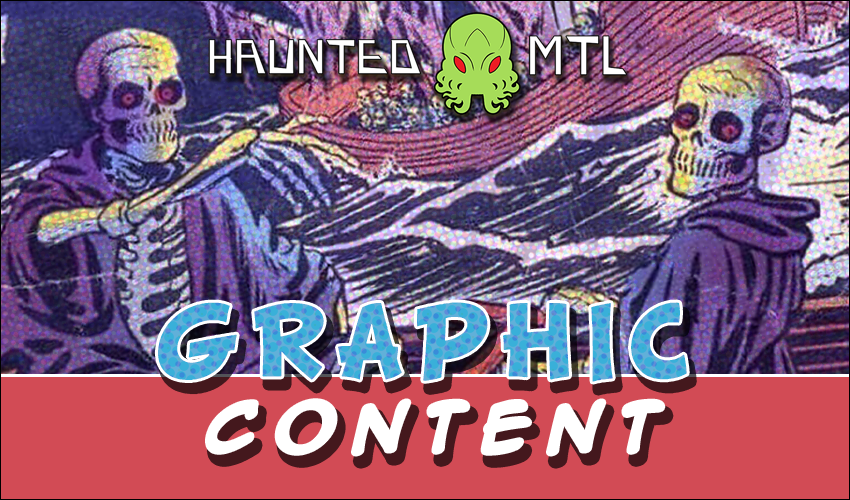
Graphic Content #4
Welcome back to Haunted MTL’s ongoing horror comic review feature, Graphic Content. In our fourth installment, we’ll be keeping up with John Constantine: Hellblazer and Sink. With previous favorite Killadelphia on break, we’re giving a new series a try titled The Grieviling, from a well-regarded horror comic team.
As always, we’re always looking for title suggestions. So please let us know in the comments what you’d like for us to tackle.
John Constantine: Hellblazer #6
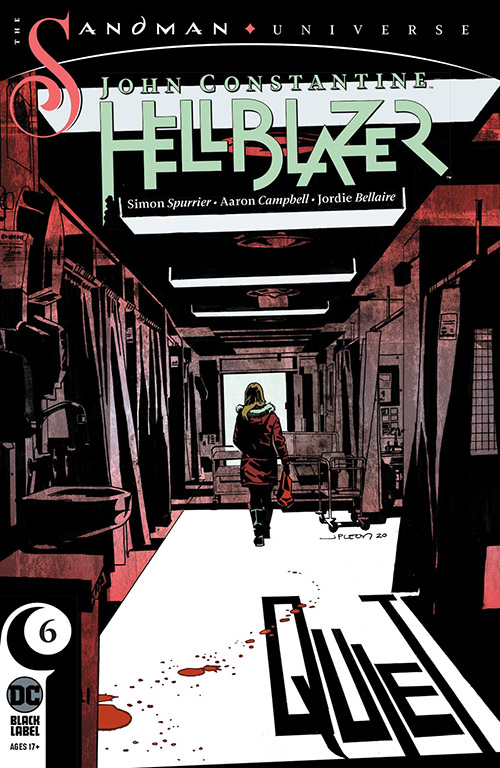
Issue #6 is a single-issue story titled “Quiet.” This issue spends some quality time with John’s newest assistant, Noah who has been floating in and out of the hospice care where his mother resides since we were introduced to his character. This episode uses time with him to examine some of the other lives within the ward, but more to the point, provide a glimpse of the ills of society. This issue plays on a larger leftist critique on the Tory government though Noah’s own story. This is classic Hellblazer storytelling; monsters and metaphors. The comic turns the satirical eye to a building of the elderly and the infirm, unable to die, turning it into a site of stalking by a ghost, feeding on the lives of the dying.
A ghost that just so happens catches the eye of John Constantine thanks to Noah. While John is quick to figure out what is going on, the day is “saved” as much as it can be in Hellblazer through Noah. John may be forever damaged goods and a right bastard, but something about him seems to make others into better people. It’s a quick, single-issue story, but it’s fine stuff.
Aaron Campbell returns to art duties and as expected his art is a perfect fit for Constantine’s world. The illustrations are about as rough as prior issues, in that the forms are solid but the lines have a rougher quality to them, like a pencil or a pen that is drying up. It gives Hellblazer‘s London a certain aura. Especially given Jordie Bellaire’s coloring style. Characters are given full-color consideration whereas the backgrounds offer more unified and slightly limited pallets. There are, of course, the glimpses of the magical world which have a very painterly and abstracted air to them. The Campbell and Bellaire team-up continues to impress.
 (4 / 5)
(4 / 5)
John Constantine: Hellblazer #6 was written by Simon Spurrier, illustrated by Aaron Campbell, and colored by Jordie Bellaire.
Sink #3
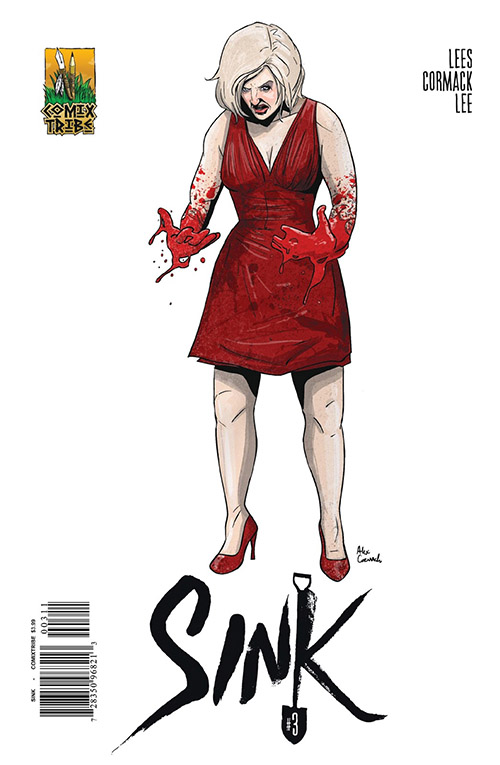
Sink #3 is a story titled “A Head Full of Wasps” and continues the anthologized glimpse at the damaged lives of Sinkhill. This time around, however, the story starts us off in Edinburgh and introduces us to another Sinkhill toughie, but one who has changed significantly in their time away from the neighborhood. The story follows the old killer, at the behest of the children of a recently passed friend, returning for revenge.
It’s a fascinating issue revolving around identities, dead-names, and again, as with the prior two issues, the ways trauma manifests within and around people in this community. Also, the clowns are back. Horrifying. While this is definitely more of a crime book, I feel comfortable tackling it as horror. I mean, sure enough, horrific things happen. If you read horror for monsters then maybe with Sink it works because the monsters themselves tend to be so abstract. Sinkhill itself is a monster. Transphobia is a monster. The various horrible bastards of each story are monsters in their own ways.
While each issue has been anthologized in tackling different figures, there are connections being formed. I also hope we see more of Florence again. That’s an interesting view of the world I’d love to experience more.
Alex Cormack’s artwork here is stunning and the paneling in a particular moment with a shattered glass is fascinating and an example of the kind of visual storytelling only ever possible in comics. Of course, the comic is also suitably bloody with buckets of gore after a particularly brutal bar brawl. Of particular notice are the way Cormack tackles scarred and lacerated hands.
 (4 / 5)
(4 / 5)
Sink #3 was written by John Lees and illustrated and colored by Alex Cormack.
The Grievling #1
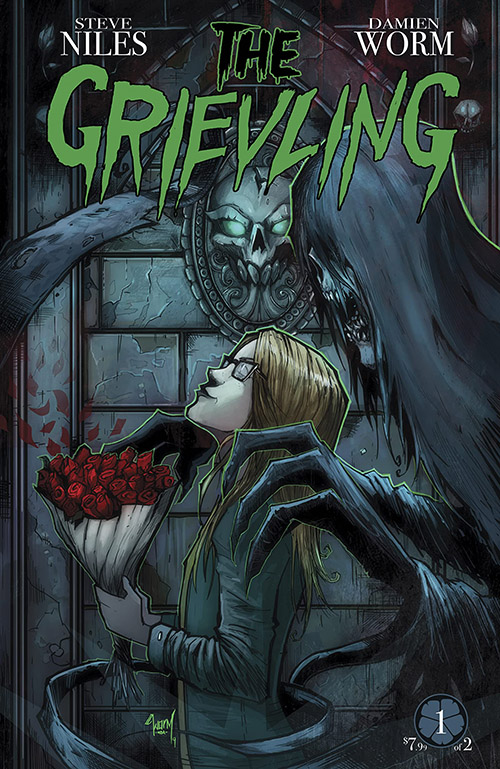
The Grievling is a two-part limited series that pairs horror-comic icon Steve Niles with artist Damien Worm. The first issue is a moody, simple tale of accidental murder and asks difficult questions of the culpability of minors.
Lily is the “weird” girl at her school. The sort of arbitrarily chosen punching bag of the normative-skewing children at her school. Lily’s time spent at the graveyard, at her mother’s grave freaks out local kids and on Halloween night their bullying of her results in tragedy. Lily comes out of the experience with a new lease on life and a strange new entity along for the ride. It’s very much like the first half of a pilot of a Netflix-style drama. It’s effective storytelling and there is a good setup to something larger, but it feels extremely calculated. Less a true desire to tell a story on its own terms and more of a desire to have a book to pitch to studios.
Granted, the story isn’t bad, and sure enough there is potential for an amazing show, but The Grievling is just a pre-visualization for something else. It’s not a comic because it needs to be a comic. It’s a marketing tool. It is a fine read, and it is interesting, don’t get me wrong.
It just feels so much like a marketing tool. The arbitrary two-issue length seems too calculated and whatever elements that interest most about the concept are not likely to be explored well enough. There is a compelling story in here about the dark side of children but that is likely not going to be explored well enough within two issues, leaving the antagonist children as just hollow characterizations of kids gone bad with little of the exploratory depth the characters deserve. Hell, Lily’s relationship with her father and the tragedy within her family also need room to breathe, but two issues just does not seem like enough space to tackle that.
Damien Worm’s artwork is great for the material and it’s no wonder Niles and Worm have continued to work together. They seem like a perfectly aligned creative entity. Their previous work on The October Faction is well regarded, and Worm’s style delivers for the story playing out in the first issue.
I just wish the end product didn’t feel so calculated for a Netflix deal.
 (3.5 / 5)
(3.5 / 5)
The Grievling #1 was written by Steve Niles and illustrated by Damien Worm.
Stay tuned for another installment of Graphic Content this month. If you have a comic you’d like to see us cover please let us know!
Book Reviews
A Stellar Debut Novel, We Used To Live Here
Imagine this. You’re home alone, waiting for your partner to return, when you hear a knock on your door. You answer it to see a family of five, bundled up against the cold. The father, a kindly older gentleman, explains that he used to live in this house as a boy. And he would love to show it to his family.
Do not let them in.
The story
Released in June 2024, We Used To Live Here is author Marcus Kliewer’s debut novel. It tells the story of Eve, who just purchased a beautiful house with her partner, Charlie. Their plan is to flip the house and sell it.
One night, while waiting for Charlie to come home, Eve is surprised by a knock at the door. It’s a man named Thomas Faust and his family.
Thomas explains that he grew up in the house and hasn’t been in the area in years. Would Eve let them in so that he can show the home to his children?
Against her better judgment, Eve lets them in. She regrets this almost at once when Thomas’s daughter vanishes somewhere into the house.
What worked
I always appreciate a book that allows you to play along with the mystery. And this book does that better than just about any other I’ve seen.
Pay close attention to the chapters, to the words that aren’t there. To everything about this novel.
This is mostly down to Kliewer. This is ultimately his work of art. But the production value is also fantastic. I don’t want to ruin the multiple mysteries, so I’ll just say this. There are clues in this book that require some specific artistic choices in the page layouts in this book. And I loved that.
If you’d like to experience another horror book review, check out this one.
We Used To Live Here is also the kind of story that makes you question everything right along with the main character, Eve. Eve is a great main character. But she might be an unreliable narrator. She might be experiencing every single horror described, exactly as it’s described. Or, she might be having a psychotic breakdown. Through most of the book, we can’t be sure. And that is so much fun.
Finally, the weather plays a large part in this story. There are several stories in which the weather or the land itself could be considered a character. Even an antagonist. This is certainly one. The winter storm is the thing that traps the family in the house with Eve. It also makes escaping the home difficult. Reading this book during the winter was especially impactful. Most of us know what it feels like to be shut in by a storm. I’ve personally lived through some of those storms that are just referred to by their year, as though they were impactful enough to claim the whole 365 days for themself. And that was with people I liked. Imagine what it would feel like with strangers. It’s a staggering thought and one that we explore in depth in this book.
In the end, We Used To Live Here is a fantastic book. It’s the sort of story that sneaks into your brain and puts down roots. And if this is just the first book we’re getting from Kliewer, I can’t wait to see what else he comes up with.
 (5 / 5)
(5 / 5)
Book Reviews
Exploring real terror with The House of My Mother
As a disclaimer, this is a review of The House of My Mother from a critical perspective. I will not be discussing my opinions of the legal case against Ruby Franke and Jody Hildebrandt. I will be discussing the merits of the book as a work of true crime alone.
In 2015, Ruby Franke started a YouTube channel called 8 Passengers. In August of 2023, Franke and her business associate Jodi Hildebrandt were arrested for, and later plead guilty to, charges of aggravated child abuse. And in January of this year, Shari Franke told her story in The House of My Mother.
The story
The House of My Mother is the true story of Shari Franke, the oldest child of one of the most famous family vlogger families.
As a child, Shari came to the conclusion that her mother didn’t like her. Soon, she began to fear her mother’s anger.
Things got significantly worse when Ruby started their family vlog. All of the families most intimate moments were splashed across the internet for anyone to watch. This became a living nightmare for Shari.
Of course, that was only the start of the family nightmare. Because Ruby was about to meet someone who would reinforce all of the darkest parts of herself.
Eventually Shari manages to escape her home. But her younger siblings were still in her mother’s clutches. She had to save them, and her father, from the monster her mother had become.
What worked
Through the book, Shari only ever mentions the name of one of her siblings, Chad. This is because Chad is the only of her siblings that is an adult at the time of the publication.
There are children involved in this story. Children who’s lives and privacy have already been damaged. Shari didn’t want to do that to them again, and neither do I.
It probably won’t surprise you that this book is full of upsetting details. But not in the way you might imagine.
Nowhere in this book will you find gory details about the abuse the Franke kids suffered. And I consider that a good thing. Those sort of details are all fun and games when we’re talking fiction. When it’s real kids who are really living with the damage, it’s not a good time.
What you’ll find instead is a slew of more emotionally devastating moments. One that stuck with me is when Ruby’s mother gives her a pair of silk pajamas as a gift after Ruby gave birth to one of her babies. Shari asks Ruby if she’d bring her silk pajamas when she had a baby. Ruby responds that yes, when Shari becomes a mother they can be friends.
What a lovely way to make a little girl feel like she’s not worth anything unless she reproduces. And, if she does decide to have children, who is going to bring her silk pajamas?
In the end, this isn’t a story about ghosts or demons. It’s not about a serial killer waiting on a playground or in the attic of an unsuspecting family. Instead, this is a story about things that really keep us up at night. It’s the story of a woman so obsessed with perfection that she drove away her eldest daughter. The story of a young woman who’s forced to watch from afar as her beloved brothers and sisters are terrorized and abandoned. These are the sorts of things that really keep us up at night. These are the real nightmares.
More than that, though, The House of My Mother is a story of survival. It’s about a family that was ripped apart and somehow managed to stitch itself back together again. It’s about a brave young woman who managed to keep herself safe and sane in the face of a nightmare. If you haven’t read it yet, I can’t recommend it enough.
For more like this, check out my review of Shiny Happy People.
 (5 / 5)
(5 / 5)
Book Reviews
Book Review of Boreal: an Anthology of Taiga Horror
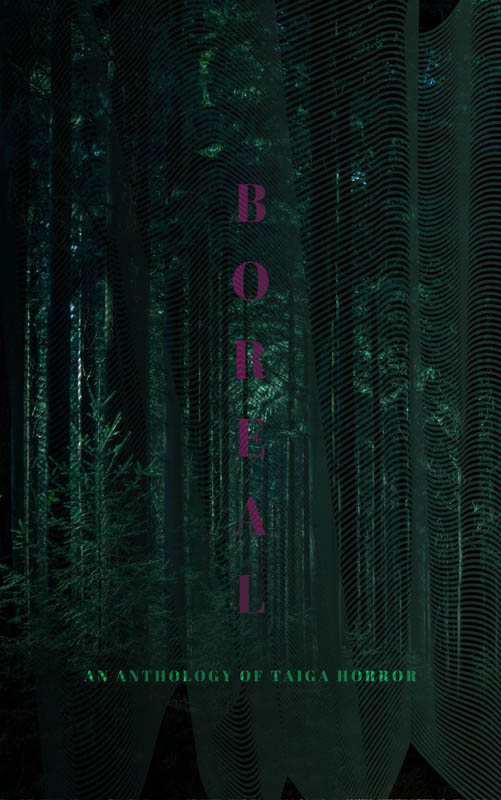
Boreal: an Anthology of Taiga Horror is a collection of twenty-two haunting tales that dwell in the deepest darkest woods and frozen wastelands, edited by Katherine Silva and including Haunted MTL’s very own Daphne Fauber. Each story has even been gifted with its very own poster, hinting at the horrors to be found within it, bestowing a beautiful visual collection as well.
The tales are varied and touch upon the environment in new and different ways, each hearkening to a sort of epiphany or raised awareness. These stories exude both dread and wonder at the smallness of our human existence in contrast to the sacred world we have isolated from, sheltering ourselves in our comfortable houses with centralized heat and everything we could possibly need or want at the ready. The taiga becomes a sanctuary outside of our own dulled awarenesses. It is a holy place imbued with powers beyond mortal human reach, a wilderness that threatens to swallow us – both whole and bit by bit, simultaneously.
The protagonists enter into this realm through ritual, superstition, longing, stubbornness, and their own hubris – yearning to survive its dangers, and to make their own marks upon it. The starkness of their surroundings harbors delicate moments that would be all too easily missed if not deliberately sought or pointed out. The softness of fur, the dappled sunlight shining through trees, the hazy clouds of breath forming in crisp air, the brittleness of bleached bone… those quiet experiences that beg to be forgotten, to lay safely sleeping just below the frozen surface, awaiting spring.
There are those who followed in the footsteps of their predecessors, seeking to escape the constraints of their parent’s and elders’ indoctrination, traditions, madness, and abuse, yearning to find their own way despite also being inextricably bound to their own pasts. There are those who just wanted to go for a walk in the woods, and remained forever changed by what they experienced. There are those who wished to impose their will upon the wilderness, their order falling to disarray, unable to make lasting impact. There are those who sought to leave behind the world of mankind, looking for oneness in the natural order of things through isolation, leaving a bit of themselves behind after being consumed by the terrors they encountered. There are those who truly found communion with the woods, became one with its wildness, and invited its spirit into their hearts to find peace, even at cost of their own lives. And then, there are the spirits themselves…
 (3 / 5)
(3 / 5)
All in all, I give Boreal: an Anthology of Taiga Horror 3.0 Cthulhus. I love existential angst so I found it to be an enjoyable read, and I appreciated the myriad manners in which the biome was explored. But there were points in which I found myself struggling to follow along, as if the words were swept up into their own wilds in ways that alienated myself as reader, as if my mere voyeurism into this otherworldly place was not enough to comprehend the subtle deviations in storytelling mannerisms fully. I suppose in some sense this seems appropriate, but at the same time, it left me feeling a bit unfulfilled, as if I had missed a spiritual connection that should have resonated more deeply.


